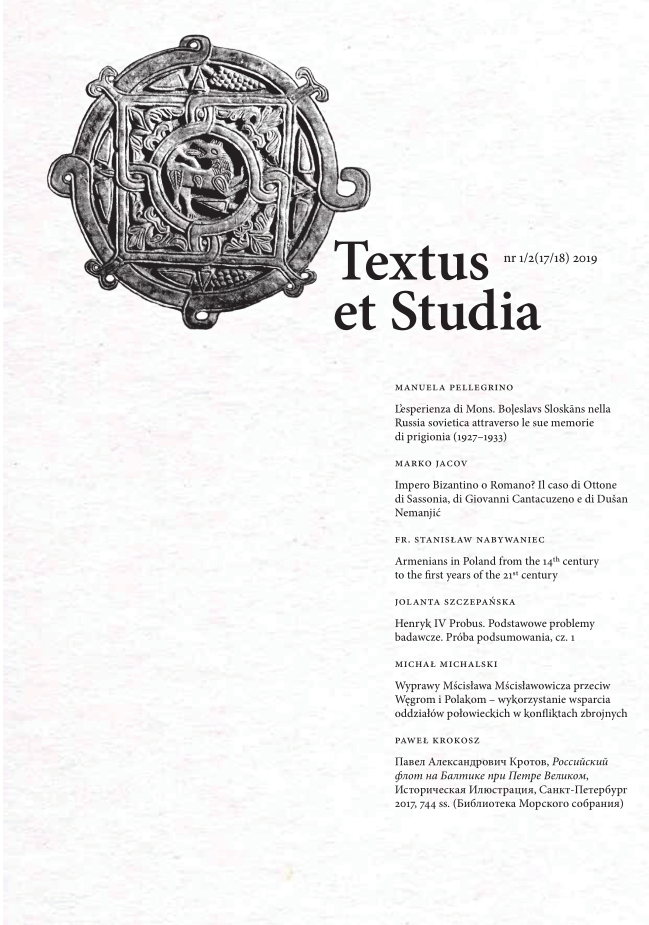Mstislav Mstislavich’s expeditions against Hungarians and Poles – supporting role of the Polovtsian troops in military conflicts
DOI:
https://doi.org/10.15633/tes.05105Keywords:
Mstislav Mstislavich, Kotyan, Rus’ Peoples, Polovtsians, Hungarians, Poles, Galich, Andrew II, Leszek the White, Coloman, Daniil Romanovich, Vasilko Romanovich, nomads, skirmishersAbstract
We know that Mstislav was married with the daughter of Polovtsian Khan Kotyan. His alliance with this Khan was one of the most important. Close contacts with Kotyan’s family had great influence on the opportunity to use the nomads in military expeditions. Polovtsian troops were used for the first time when the Alexander Prince of Belz moved to the enemy side (Leszek the White). Mstislav arrived in the company of the Polovtsian troops and supported Daniil and Vasilko. However, at this time he did not capture the Galich. Two years later Mstislav once again reached to the Polovtsian troops for help. In this case, nomads were used as reconnaissance troops (advance scouts) with the purpose to protect the main force and to recognize the situation at the place of the battle. The nomads arrived a day before the troops of Mstislav, their target was to “look” at the enemy troops. As we read in the Galician–Volynian Chronicle, Polovtsy completed their task superbly. Their help in the expedition contributed to the victory and enabled Mstislav to take control over the Galich.
References
Ioannis Dlugossii Annales seu Cronicae Incliti Regni Poloniae, lib. 6, S. Budkowa, I. Garbacik, A. Kamiński (ed.), Varsaviae 1973.
Nicephori Bryenni Historiarum Libri Quatuor [w:] Corpus Fontium Historiae Byzantinae, vol. 9, P. Gautier (ed.), Bruxelles 1975.
Ипатьевская Летопись [w:] Полное Собрание Русских Летописей, т. 2, Москва 2001.
Лаврентьевская Летопись [w:] Полное Собрание Русских Летописей, т. 1, Москва 2001.
Летопись по Воскресенскому списку [w:] Полное Собрание Русских Летописей, т. 7, Санктпетербург 1856.
Московский летописный свод конца XV века [w:] Полное Собрание Русских Летописей, т. 25, Москва 1949.
Новгородская летопись по Синодальному Харатейному списку [w:] Полное Собрание Русских Летописей, т. 3, Санкт-Петербургь 1888.
Симеоновская лѣтопись [w:] Полное Собрание Русских Летописей, т. 18, Санкт-Петербург 1913.
Bartnicki M., Polityka zagraniczna księcia Daniela Halickiego w latach 1217–1264, Lublin 2005.
Baumgarten N. de, Généalogies et marriages occidentaux des Rurikides russes du Xe au XIIIe siècle, „Orientalia Christiana” 1927, vol. 35, s. 1–96.
Bonarek J., Bizancjum w dobie bitwy pod Mantzikert. Znaczenie zagrożenia seldżuckiego w polityce bizantyńskiej w XI wieku, Kraków 2011.
Dąbrowski D., Daniel Romanowicz król Rusi: (ok. 1201–1264): biografia polityczna, Kraków 2012.
Dąbrowski D., Genealogia Mścisławowiczów. Pierwsze pokolenia (do początku XIV wieku), Kraków 2008.
Dąbrowski D., Przystąpienie Mścisława Mścisławowicza do walk o Halicz, „Княжа доба: історія і культура” 2012, Вип. 6, s. 119–139.
Dimnik M., The Dynasty of Chernigov, 1146–1246, Cambridge 2003.
Friendly A., The Dreadful Day. The Battle of the Manzikert 1071, London 1981.
Haldon J., Warfare, State and Society in the Byzantine World, 565–1204, London 1999.
Jusupović A., Bojar czy ksiaze? “Uzurpacje” Wołodysława Kormiliczicza w narracji Kroniki halicko-wołynskiej, „Княжа Доба. Історія і культура” 2013, Вип. 7, s. 137–146.
Kotljar M.F., Z historii polityki zagranicznej książąt halickich i wołyńskich w XIII wieku, „Mazowieckie Studia Humanistyczne” 2000, nr 1–2, s. 25–40.
Macartney C.A., The Pechenegs, „The Slavonic Review” 1929, vol. 8, s. 342–355.
Maroń J., Koczownicy i rycerze. Najazd MongołĂłw na Polskę w 1241 roku na tle sztuki wojennej Europy XII i XIII w., Wrocław 2001.
Nagirnyj W., Polityka zagraniczna księstw ziem halickiej i wołyńskiej w latach 1198 (1199)–1264, Kraków 2011.
Nagrodzka-Majchrzyk T., Czarni Kłobucy, Warszawa 1985.
The Hypatian Codex, Part Two: The Galician–Volynian Chronicle, G.A. Perfecky (ed.), Munich 1973.
Tobias N., The Tactics and Strategy of Alexius Comnenus at Calavrytae, 1078, „Byzantine Studies/Études Byzantines” 1979, vol. 6, s. 193–211.
Tryjarski E., Pieczyngowie [w:] K. Dąbrowski, T. Nagrodzka-Majchrzyk, E. Tryjarski, Hunowie Europejscy, Protobułgarzy, Chazarowie, Pieczyngowie, Wrocław 1975, s. 483–616.
Wojnowski M., Konnica w armii Cesarstwa Bizantyńskiego od VIII do XIII w. Rola militarna i znaczenie społeczne, Oświęcim 2014.
Богуславский В.В., Славянская энциклопедия. Киевская Русь-Московия, т. 1, Москва 2005.
Войтович Л., Князівські династії Східної Європи (кінець IX – початок XVI ст.). Склад, суспільна і політична роль. Історико-
генеалогічне дослідження, Львів 2000.
Волощук М., „Вокняжение” галицьке Володислава Кормильчича (1210–1214 рр., з перервами): мыфи ы реальнысть [w:] Historické štúdie k životnému jubileu Zuzany Ševčikovej, M. Daniš (red.), Bratislava 2009, s. 104–110.
Донской Д.В., Рюриковичи: Исторический словарь, Москва 2008.
Грушевський М., Історія України-Руси, т. 2: XI–XIII вік, Kиïв 1992.
Грушевський М., Історія України-Руси, т. 3: до року 1340, Kиïв 1993.
Грушевський М., Хронольогія подій Галицько-волинської літописи, „Записки Наукового товариства імені Шевченка” 1901, т. 41, s. 1–72.
Гусейнов Р.А., Сельджукская военная организация, „Палестинский сборник” 1967, № 17, s. 131–147.
Майоров A.B., Галицко-Волынская Русь. Очерки социально-политических отношений вдомонгольский период. Князь, бояре игородская община, Санкт-Петербург 2001.
Котляр М.Ф., Данило Галицький. Біографічний нарис, Київ 2002.
Котляр М.Ф., Дипломатия Южной Руси, Санкт-Петербург 2003.
Осіпян О., Поширення християнства серед половців в XI–XIV ст., „Київська старовина” 2005, т. 2, s. 3–28.
Пашуто В.Т., Внешняя политика Древней Руси, Москва 1968.
Пашуто В.Т., Очерки по истории Галицко-Волынской Руси, Москва 1950.
Толочко П.П., Династические браки на Руси ХII–ХIII вв., Санкт-Петербург 2013.
Харди Ђ., Наследници Кијева између краљевске круне и татарског јарма; студија о државно-правном положају Галичке и Галичко-Волинске кнежевине до 1264. године, Нови Сад 2002.
Downloads
Published
Issue
Section
License
Copyright (c) 2021 Michał Michalski

This work is licensed under a Creative Commons Attribution-NonCommercial-NoDerivatives 3.0 Unported License.
Authors publish under the Attribution-NonCommercial-NoDerivs 2.0 Generic (CC BY-NC-ND 2.0) license. In this case, authors have a range of rights, including:• The right to share or reuse their article in the same ways permitted to third parties under
• They can "copy and redistribute the material in any medium or format for any purpose, but not commercially. The licensor cannot revoke these freedoms as long as you follow the license terms."
• Authors retain patent, trademark, and other intellectual property rights (including research data).
• Authors receive proper attribution and credit for the published work.

